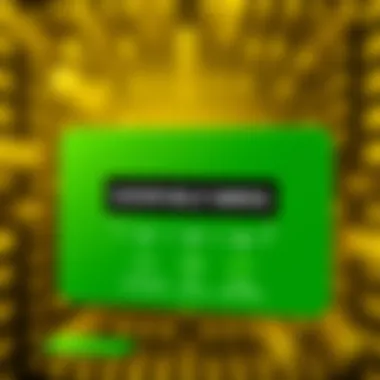Locate Your Blockchain Wallet Address: A Detailed Guide


Intro
In the quickly changing world of cryptocurrency, having a firm grasp on where to find your blockchain wallet address is like holding a treasure map in your hand. Every interaction you have in the digital asset landscape hinges on this simple string of characters. It's your unique identifier in a realm filled with codes and ciphers, guiding transactions safely to and from your digital coffers. With the concept of ownership becoming increasingly intricate, knowing how to locate your wallet address is not just useful—it's essential.
Understanding Cryptocurrency Concepts
Blockchain Technology Explained
To get started, it’s essential to simplify what blockchain technology entails. At its core, blockchain is a distributed ledger that maintains a record of all transactions across a network of computers. Imagine this ledger like an open book kept in a public library, where anyone can check what’s written down. Rather than being stored on a solitary server, the record exists simultaneously on countless devices, creating a refreshingly transparent environment.
This means that every time you send or receive cryptocurrency, a new entry is created and validated by countless users. This decentralization not only secures the data but also helps prevent fraud or manipulation. Such integrity has made blockchain the cornerstone of cryptocurrencies, making it critical for users to know their wallet address in order to partake in this innovative system.
Key Terms Every Investor Should Know
When discussing blockchain wallets, some vocabulary can trip people up. Here are a few must-know terms that will aid your understanding:
- Wallet Address: This is a digital string, often resembling random letters and numbers, that acts as your public key. Think of it as your email address in the crypto world.
- Private Key: This private code allows access to your wallet. Safeguarding it is paramount; losing it means losing access to your funds. It’s crucial to treat it like the keys to your house.
- Cold Wallet vs. Hot Wallet: A hot wallet is connected to the internet, making transactions easier but potentially exposing you to hacks. A cold wallet, however, is offline, keeping your assets much safer. You might think of it as a savings account versus a checking account.
Understanding these concepts will provide a clearer lens through which to view the process of locating your wallet address.
Locating Your Blockchain Wallet Address
How to Find Your Address on Different Platforms
The methods for locating your blockchain wallet address can vary depending on the platform you are using. Here’s a quick outline of how you might do this on some popular platforms:
- Coinbase:
- MetaMask:
- Binance:
- Log into your account.
- Click on your portfolio.
- Select the cryptocurrency you want.
- Hit the "Receive" button to display your wallet address.
- Open MetaMask and unlock your wallet.
- Your address is displayed at the top of the window, just below your account name.
- Go to your wallet section after logging in.
- Choose the specific coin.
- Click on "Deposit" to retrieve your wallet address.
For each platform, make sure you are on the official website to avoid phishing scams.
Important Note: Always double-check the address before sending funds. A single character out of place can lead to irreversible loss of assets.
Significance of Wallet Addresses
Understanding the importance of wallet addresses goes beyond the mechanics of sending and receiving funds. Each address serves as a unique identifier and opens a window into the entire blockchain infrastructure. This means:
- It tracks transaction history.
- It confirms ownership and can be used for audits.
- It allows for anonymity depending on the type of wallet used.
The implications of these characteristics stretch across security, privacy, and compliance.
Tips for Secure Wallet Management
To mitigate risks, consider these practices for managing your wallet:
- Enable Two-Factor Authentication (2FA): A solid extra layer of security against unauthorized access.
- Regular Backups: Schedule regular backups of your wallets, particularly for hot wallets.
- Use Strong Passwords: Simple advice, but always effective. Consider using a mix of letters, numbers, and special characters.
- Stay Updated: Keep your app and software updated to fend off potential vulnerabilities.
By grasping these concepts, investors and enthusiasts alike can navigate confidently in the blockchain space. This leads to more informed decisions, robust strategies, and ultimately—swifter mastery of the crypto landscape.
For further insights into blockchain technology and cryptocurrency, you might find resources at Wikipedia, or engage with discussions on platforms such as Reddit.
Each detail adds a layer of understanding, reminding you that every bit of information brings you one step closer to being a savvy crypto player.
Preamble to Blockchain Wallets
Understanding blockchain wallets is fundamental to navigating the rapidly evolving world of cryptocurrencies. In this article, we’ll peel back the layers of what a blockchain wallet is, why it matters, and how it functions within the digital finance ecosystem. The growing reliance on digital currencies has made it essential for users—ranging from casual enthusiasts to seasoned investors—to familiarize themselves with the various types of wallets available and how they can store and manage their assets securely.
Defining Blockchain Wallets
At its core, a blockchain wallet serves a dual purpose: it allows users to send and receive cryptocurrencies and provides a means to monitor their balance. Unlike traditional wallets that hold physical currency, blockchain wallets do not store money but rather the keys that grant access to your funds on the blockchain. This difference highlights the need for understanding concepts like public and private keys, both of which underpin the functionality of a blockchain wallet. Essentially, the public key is like your email address, enabling others to send you assets, while the private key is akin to your password—safeguarding access to your funds.
Types of Wallets
When venturing into the world of cryptocurrency, the type of wallet you choose can have a significant impact on your experience and security. Each type of wallet comes with its own unique features, allowing users to select according to their specific needs and comfort levels. Here, we’ll discuss three prominent categories: Hot Wallets, Cold Wallets, and Hardware Wallets.


Hot Wallets
Hot wallets are known for their convenience. These wallets connect to the internet, which makes them accessible for quick transactions. They include web wallets, mobile apps, and desktop applications—essentially any wallet that operates online.
- Key Characteristic: The main benefit of hot wallets lies in their ease of use. Users who need to make frequent transactions favor these wallets, as they allow quick and hassle-free access to funds.
- Unique Feature: Hot wallets often come with user-friendly interfaces, making them suitable for beginners. However, this accessibility comes at a price; being online means they’re susceptible to hacking and phishing attempts. While they serve well for daily transactions, storing large amounts of cryptocurrency in a hot wallet is generally not recommended due to security risks.
Cold Wallets
On the flip side, cold wallets are designed for enhanced security. They are not connected to the internet, making them less vulnerable to cyber attacks. Cold wallets can take the form of paper wallets or even USB drives loaded with cryptographic keys.
- Key Characteristic: Cold wallets are often favored by long-term holders who want to keep their assets away from the prying eyes of hackers. Their offline nature protects them from online threats, making them a secure option for significant holdings.
- Unique Feature: The downside to cold wallets is the lack of convenience. Accessing your funds can be cumbersome, especially if you forget where you've stored your keys or if you lose the device. This inconvenience becomes a tangible trade-off for enhanced security, ensuring that your digital assets remain safe and secure.
Hardware Wallets
Hardware wallets combine elements of both hot and cold storage. They are physical devices that store the user’s private keys offline while providing a convenient way to manage cryptocurrency transactions.
- Key Characteristic: Hardware wallets are celebrated for their security features, as they keep your keys isolated from the internet until required for a transaction.
- Unique Feature: While they offer superior security, there is a cost attached—both financially and in terms of setup. Users must invest in the hardware, and navigating their interfaces may require some time investment to learn. However, for those serious about safeguarding digital assets, the trade-off can be worth its weight in gold.
Understanding these wallet types provides a solid foundation as we delve deeper into the various ways to locate and manage blockchain wallet addresses in subsequent sections.
Understanding Wallet Addresses
Understanding blockchain wallet addresses is like knowing the postal service for digital currencies; without it, sending and receiving funds would be as confusing as reading a map upside down. These addresses serve as identifying markers in a decentralized network, allowing users to manage their assets securely and efficiently. Knowing how addresses function is not just beneficial, it’s essential for anyone venturing into the world of cryptocurrencies.
Wallet addresses have several key characteristics that set them apart. For one, they are essentially strings of alphanumeric characters, and their length can vary by the type of blockchain. The complexity of these structures does not just add a layer of security; they also help to protect users from fraud and errors during transactions. A clear grasp of wallet addresses also contributes to improved user experience, ensuring smoother transactions and reducing the risks of lost funds.
What is a Wallet Address?
A wallet address is akin to your bank account number, but instead of being tied to a traditional financial institution, it operates within a digital currency ecosystem. This address is generated by your wallet software and represents a unique point of interaction for receiving cryptocurrency. Each blockchain network has its own format and set of rules for these addresses, which can range from a string of 26 to 42 characters or more, depending on the underlying technology.
It's important to note that while wallet addresses can often be shared freely, they are still sensitive information. Sharing an address can lead to unwanted attention, making privacy a key consideration for any crypto enthusiast. Furthermore, every time you receive funds, your wallet software generates a new address, making it crucial to keep track of these different identifiers for effective account management.
How Wallet Addresses Work
Understanding how wallet addresses function is fundamental in grasping the concepts of blockchain transactions. Let’s break it down into two major components: public and private keys, followed by the process of address generation.
Public and Private Keys
Public and private keys are foundational elements in cryptocurrency systems. The public key is like your email address; it can be shared with anyone without fear. People use it to send you funds. The private key, however, is like your password—something you should keep to yourself at all costs. This key grants access to your funds within your wallet; without it, you wouldn't be able to authorize transactions.
What makes this setup beneficial is its built-in security. Since the public and private keys are mathematically related, it's virtually impossible for someone to deduce your private key from your public key. This characteristic contributes to a high level of security in the operations of cryptocurrency transactions, which is a major draw for users.
Address Generation
Address generation is the process of creating a unique wallet address, and it’s more complex than it sounds. When you create a new wallet, the software generates a public key, followed by deriving the wallet address from this public key using various hashing algorithms, like SHA-256.
This method of address generation significantly boosts security, since each wallet address is unique and can’t be easily guessed. However, this uniqueness also introduces some challenges. For instance, users must always ensure they’re using the correct address for transactions. Sending funds to the wrong address can result in the permanent loss of those funds.
Understanding both how wallet addresses work and their underlying security mechanisms is crucial for navigating the world of cryptocurrencies. Grasping these concepts helps ensure users manage their assets wisely, minimizing the chances of costly mistakes.
Finding Your Blockchain Wallet Address
Finding your blockchain wallet address is an essential skill in the world of digital currency. This address acts as your destination for sending and receiving funds in the blockchain ecosystem. Understanding how to locate it not only enables you to manage your assets effectively, but it also serves as a foundation for secure transactions. Without a grasp of wallet addresses, one might encounter challenges, leading to potential financial mishaps or loss of funds. Thus, this guide provides methods tailored to various platforms, ensuring readers can confidently navigate this critical aspect of blockchain technology.
Via Wallet Software
Steps for Desktop Wallets
Desktop wallets are often favored by users who prefer a robust solution that gives them direct control over their private keys. To find your wallet address using a desktop wallet, you can generally follow these steps:
- Open your wallet application.
- Log in with your credentials.
- Navigate to the 'Receive' or 'Account' section.
In this area, you will typically find your wallet address displayed prominently. A standout feature of desktop wallets is their capacity for enhanced security, as they are less exposed to online threats compared to hot wallets. However, users must remain vigilant about maintaining their software and personal security, as any oversight could lead to vulnerabilities.
Steps for Mobile Wallets
Mobile wallets provide convenience and quick access, often making them the go-to option for users on the move. The process of locating your wallet address on a mobile application usually entails:
- Launching your wallet app.
- Accessing your account dashboard.
- Selecting the 'Receive' option.
This user-friendly interface allows for quick transactions, which can be particularly advantageous during fast-paced trading moments. But, it’s crucial to remember that with convenience comes risk. Mobile devices can be targets for malware, highlighting the importance of using reputable apps and enabling security features such as multi-factor authentication.
Using Web Wallets


Accessing Your Account
Web wallets are convenient platforms to manage your cryptocurrency without the need for software downloads. To find your wallet address in a web wallet, follow these steps:
- Open your browser and navigate to the wallet’s website.
- Log in to your account using your credentials.
- Look for the 'Receive' or 'Addresses' section on your dashboard.
The accessibility of web wallets can be appealing; however, they are often seen as less secure than their desktop or mobile counterparts. The reliance on third-party providers for security means that you must choose reputable platforms, checking user reviews and security features before committing your funds.
Navigating Dashboard Features
Many web wallets offer intuitive dashboards that give an at-a-glance view of your assets and activity. Familiarizing yourself with these features can enhance your user experience:
- Portfolio management tools
- Transaction history
- Security settings
Knowing where to find your wallet address and understanding the dashboard can simplify your dealings in cryptocurrency. Still, always be aware of potential phishing attempts and ensure your session is secure before entering any sensitive information.
Exploring Exchange Platforms
Finding Wallet Addresses on Exchanges
Exchanges like Binance or Coinbase also provide wallet addresses for users to receive funds. To find your address:
- Log into your exchange account.
- Go to the 'Wallet' or 'Assets' section.
- Select the cryptocurrency you want to receive, and you’ll find your address displayed.
While exchange platforms offer a range of features for trading and managing funds, it’s essential to stress that storing cryptocurrency on exchanges carries risks. Hacks and disruptions can lead to the loss of funds, and it's often safer to transfer assets into a cold or hardware wallet for long-term storage.
Withdrawals and Transfers
To withdraw or transfer funds from your exchange, the procedure usually involves:
- Navigating to the 'Withdraw' section.
- Inputting the recipient’s wallet address.
- Confirming the transfer by following the prompts.
This process requires careful attention; entering the wrong address can lead to irreversible losses. Exchanges typically provide safeguards to confirm transactions, but always double-check every detail before proceeding. Thus, the understanding of wallet addresses extends beyond just obtaining them to ensuring their accuracy during transfers.
Importance of Wallet Addresses
Understanding wallet addresses is critical for anyone navigating the blockchain landscape. These alphanumeric strings serve as the identifiers where digital assets like cryptocurrencies are sent or received. By grasping their significance, users enhance their transaction efficiency and security.
Sending and Receiving Funds
When it comes to trading or simply transferring funds, wallet addresses act as the cornerstone. They ensure that the right recipient is receiving the appropriate amount. For example, when sending Bitcoin, you must enter the recipient’s wallet address accurately; any mistake can lead to irreversible loss. Think about it: writing a check without confirming the account number first would be ill-advised. It’s the same with blockchain transactions.
Moreover, the decentralized nature of blockchain means traditional transaction methods—like email or phone numbers—are non-existent. This further emphasizes the necessity of understanding the address structure and ensuring you have the correct address before proceeding with transactions. Addresses can vary based on the currency; for instance, Bitcoin addresses begin with a ‘1’ or ‘3,’ while Ethereum addresses begin with ‘0x’.
Security Implications
While wallet addresses are essential for the movement of funds, they also come with significant security implications. Knowledge of how to manage and protect these addresses can safeguard your assets against theft or loss. Here’s why it’s crucial to be aware of the potential risks and measures you can take to enhance your privacy.
Risks of Sharing Addresses
One of the distinct risks associated with wallet addresses is the possibility of exposure. Sharing your wallet address openly might seem harmless, but it opens several avenues for malicious attacks. For instance, it can lead to phishing attempts where a bad actor tricks you into revealing your private keys or other sensitive information. The key characteristic of this risk is that, while wallet addresses are meant for facilitating transactions, public access can undermine your privacy and security.
Imagine telling everyone your bank account details; how safe would you feel? In blockchain, broadcasting your wallet address can invite unwanted attention or, worse, fraud.
Best Practices for Privacy
Maintaining privacy when dealing with blockchain wallet addresses is paramount. To maintain a secure presence in the digital asset landscape, consider the following best practices:
- Use Unique Addresses: Each transaction could utilize a unique address, enhancing anonymity.
- Avoid Public Sharing: Keep your wallet addresses private; share them only when absolutely necessary.
- Utilize Privacy Networks: Platforms like Monero or Zcash provide enhanced privacy features.
These practices highlight the uniqueness of wallet addresses, making them not just transactional tools but also significant elements of your digital security. By avoiding unnecessary exposure of your wallet addresses, you’re not just protecting your crypto; you’re safeguarding your financial autonomy.
Troubleshooting Common Issues
In the fast-evolving world of blockchain technology, encountering issues when locating your wallet address can feel like a thorn in your side. It's essential to address these troubles head-on, as they can affect your ability to manage digital assets swiftly and safely. When issues arise, understanding how to troubleshoot effectively not only enhances your user experience but also prevents potential losses, ensuring seamless operations in your blockchain dealings. Let’s dive into the specifics of common problems users may face.
Address Format Problems
One of the most common issues involves the format of blockchain wallet addresses. Each cryptocurrency utilizes a unique format, and discrepancies in input can lead to complications. If you enter an address in the incorrect format, you might not send your funds at all or worse, you could risk losing them.
Example of Common Address Formats:
- Bitcoin: Begins with a '1', '3', or 'bc1'
- Ethereum: Starts with '0x'
Paying careful attention to these formats is crucial. If you mistakenly add extra characters or reverse letters, it throws a wrench in the gears. For instance, if you mix up a 'l' with a '1', it can change the whole thing, leading your coin on a wild goose chase into the crypto-ether without ever reaching its destination.
Why Can't Find My Address?


There are few feelings worse than searching for your crucial blockchain wallet address and coming up empty-handed. Several reasons might explain the elusiveness of your wallet address, typically revolving around compatibility and connectivity issues.
Compatibility Issues
Compatibility issues can arise when using different platforms to access your wallet. For instance, not all wallets support the same cryptocurrencies, leading to confusion about what address types can actually be retrieved.
A key characteristic of compatibility issues is that they often stem from inconsistent updates. If your wallet software is outdated, it might create discrepancies in how addresses are generated or presented. This reinforces the importance of keeping your software updated. A unique feature of addressing compatibility issues is knowing the specifications for your wallet and ensuring they align with the cryptocurrency in question. If you want fluidity and reliability, sticking with well-known wallets like Exodus or Atomic Wallet, which are widely recognized for their compatibility across multiple cryptocurrencies, is beneficial. However, be mindful; if the wallet's platform does not support a specific cryptocurrency, you will simply not see that address.
Connectivity Problems
Connectivity problems represent another hurdle when locating your wallet address. These issues are often about your internet connection, causing stress when your wallet app can’t synchronize with the network.
The primary characteristic of connectivity problems is often temporary. You might find that a sluggish internet connection is your nemesis, or you’re just having a bad day at your local coffee shop with spotty Wi-Fi.
Unique to connectivity challenges is the dependence on stable networks. If you are trying to access your wallet under unfavorable conditions, such as a weak mobile signal, be prepared for interruptions. This could lead to an inability to retrieve your address when you need it the most. There’s a silver lining here though; if you consistently rely on a strong and stable internet connection or a dedicated local network, such as a home Wi-Fi, you reduce the chances of running into this issue.
A solid understanding of both address formats and issues related to connectivity can help navigate potential roadblocks, ensuring your access to blockchain wallet addresses remains uninterrupted.
Future of Blockchain Wallets
The future of blockchain wallets holds immense significance in the domain of digital assets and transactions. This evolution is not merely about adapting to new technologies; it encompasses the enhancement of security, user experience, and integration into broader financial ecosystems. As blockchain technology continues to mature, it becomes pivotal to examine how these wallets will evolve to meet the needs of investors, traders, and casual users alike.
Emerging Technologies
Emerging technologies are shaping the landscape of blockchain wallets, making them more advanced and user-friendly. Innovations like smart contracts, augmented functionalities, and advanced encryption methods are essential elements driving this transformation. The incorporation of artificial intelligence and machine learning is also on the rise, allowing wallets to automate complex processes and improve the decision-making time for users.
Blockchain wallets are likely to incorporate
- Multi-signature functionality: This feature can enhance security, requiring multiple keys to authorize a transaction, thus reducing the likelihood of hacking.
- Biometric verification: A common method to improve security, which can facilitate easier access while maintaining high levels of protection.
These technologies collectively improve trustworthiness and usability, steering the blockchain wallet sector towards greater sophistication.
User Experience Enhancements
More Intuitive Interfaces
User experience is an increasingly important aspect of blockchain wallet design. A more intuitive interface makes interacting with these wallets simpler for everyone, regardless of their technological proficiency. Key characteristics of these interfaces include clarity, ease of navigation, and interactive elements that make the experience smooth. These are designed, in part, to reduce the cognitive load on users who may find complex interfaces daunting.
One unique feature of intuitive interfaces is their ability to offer step-by-step guidance for transactions. This is beneficial, as it minimizes user errors and fosters a sense of confidence in handling digital assets.
However, a downside might be the potential oversimplification that could hide advanced features from experienced users, limiting their ability to utilize all functions effectively. Striking a balance between simplicity and advanced functionalities remains a challenge.
Integration with Other Services
Integration with other services is another critical enhancement in the user experience of blockchain wallets. Connectivity with decentralized finance (DeFi) protocols, exchanges, and non-fungible token (NFT) platforms is becoming more prevalent. This integration enables users to access a wider array of financial services all from within their wallet, making transactions more seamless.
One vital characteristic of this integration is the use of APIs (Application Programming Interfaces) that allow different platforms to communicate with each other. This opens the door to innovation, as new services can build on existing wallet capabilities, thus enriching the overall ecosystem.
A distinct benefit of this integration is how it can enhance liquidity and accessibility of funds, allowing users to make immediate transactions or exchanges at lower costs.
Nevertheless, there are considerations regarding security and privacy when integrating with multiple services. Users must remain vigilant about potential vulnerabilities that these interconnected systems introduce. Overall, the trend towards integration promises to create a more cohesive experience for blockchain wallet users.
"As technology advances, staying informed and adaptable will ensure you're not left behind in this rapidly evolving landscape."
In summary, the advancements in blockchain wallets through emerging technologies and user experience enhancements are set to redefine how individuals engage with digital currencies. Investors and enthusiasts alike must stay abreast of these changes to harness the full potential of their blockchain wallets.
The End
In summing up the vital points discussed throughout this article, it becomes apparent that understanding how to locate your blockchain wallet address is not merely a technical necessity; it’s essential for secure and efficient digital asset management. The interplay between the nuances of different wallet types and platforms underscores the need for tailored approaches to address retrieval based on user preferences and needs.
The significance of wallet addresses extends beyond just enabling transactions. They embody unique identifiers that serve as gateways for transfers—be it sending or receiving cryptocurrencies. A misstep in addressing, say entering an address incorrectly or not using the right format, can lead to loss of funds. Therefore, a comprehensive grasp of both the methods for discovering wallet addresses and the implications of their use is crucial for anyone engaging in the blockchain space.
Moreover, the future seems bright as emerging technologies continually refine the usability and security associated with wallets. The convenience afforded by exchanges and the growing sophistication of software wallets would suggest that managing one's digital assets could become even less daunting. Yet, with rapid advancements, prudent practices around privacy and security must keep pace. Educating oneself about the risks and engaging with best practices remain cornerstones of safe cryptocurrency handling.
Ultimately, the knowledge gained from this guide equips users—novices and seasoned traders alike—with the confidence to navigate their wallets with ease, ensuring their blockchain journey is a fruitful one.
Recap of Key Points
- Understanding Wallet Addresses: A unique identifier for transactions in the blockchain realm.
- Different Methods of Locating Addresses: Desktop, mobile, web wallets, and exchanges each have specific procedures.
- Security Considerations: Sharing addresses carries risks, and understanding best practices is essential for privacy.
- Emerging Trends: User experience enhancements and technological advancements may simplify wallet management.
Final Thoughts on Wallet Management
Managing a blockchain wallet goes beyond just knowing your address. It involves developing a comprehensive strategy for securing your funds, staying abreast of changing technologies, and recognizing the importance of proactive measures regarding privacy. The landscape of blockchain wallets promises to evolve continuously, presenting new challenges and opportunities. Thus, staying informed is not just advantageous but indispensable. Strive to maintain a balanced approach between convenience and security, navigating this exciting yet intricate domain with confidence and insight.
"Education is the most powerful weapon which you can use to change the world."
— Nelson Mandela
For additional resources and detailed information, consider exploring Wikipedia, Britannica, and relevant community discussions on Reddit.















